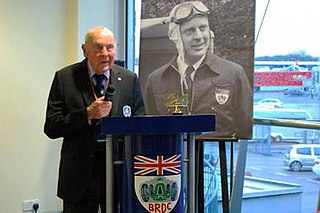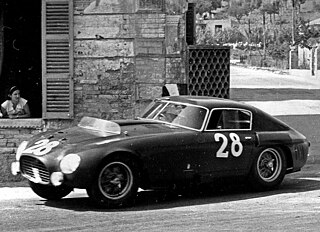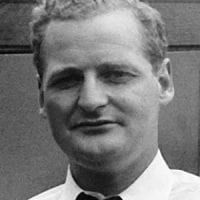Related Research Articles

The Circuit de Spa-Francorchamps, frequently referred to as Spa, is a 7.004 km (4.352 mi) motor-racing circuit located in Stavelot, Belgium. It is the current venue of the Formula One Belgian Grand Prix, hosting its first Grand Prix in 1925, and has held a Grand Prix every year since 1985.
George Edgar Abecassis was a British racing driver, and co-founder of the HWM Formula One team.

Peter John Collins was a British racing driver. He was killed in the 1958 German Grand Prix, just weeks after winning the RAC British Grand Prix. He started his career as a 17-year-old in 1949, impressing in Formula 3 races, finishing third in the 1951 Autosport National Formula 3 Championship.

Roy Francesco Salvadori was a British racing driver and team manager. He was born in Dovercourt, Essex, to parents of Italian descent. He graduated to Formula One by 1952 and competed regularly until 1962 for a succession of teams including Cooper, Vanwall, BRM, Aston Martin and Connaught. Also a competitor in other formulae, he won the 1959 24 Hours of Le Mans in an Aston Martin with co-driver Carroll Shelby.

Adolf Brudes von Breslau was a Formula One driver from Germany and a member of German nobility. He started racing motorcycles in 1919. As an owner of a BMW and Auto Union dealership in Breslau, he had the opportunities to go racing, which he did from 1928 onwards, initially in hillclimbs. After World War II wiped out his business, he moved to Berlin and for a while became a mechanic, wherever he could find jobs. However he soon was back racing, and he continued until 1968, in hillclimbs – an amazing career of 49 years! He participated in one World Championship Grand Prix, the 1952 Großer Preis von Deutschland, but scored no championship points. He also participated in several non-Championship Formula One races.

Ivor Léon John Bueb was a British professional sports car racing and Formula One driver from England.

Road Atlanta is a 2.540 mi (4.088 km) road course located just north of Braselton, Georgia, United States. The facility is utilized for a wide variety of events, including professional and amateur sports car and motorcycle races, racing and driving schools, corporate programs and testing for motorsports teams. The track has 12 turns, including the famous "esses" between turns three and five; and Turn 12, a downhill, diving turn. The track is owned by IMSA Holdings, LLC through its subsidiary Road Atlanta, LLC, and is the home to the Petit Le Mans, as well as AMA motorcycle racing, and smaller events throughout the year. Michelin acquired naming rights to the facility in 2018.

Eric David Thompson was a British racing driver, book dealer and insurance broker. He participated in sports car racing between 1949 and 1955 taking his greatest success by finishing third in the 1951 Les 24 Heures du Mans and took part in the 1952 RAC British Grand Prix.

The Ferrari 250 S was a sports racing car produced by Ferrari in 1952. It was the first in the long lineage of Ferrari 250 road and race cars powered by a ubiquitous 3.0-litre Colombo V12 engine. In 1952 the 250 S won the Mille Miglia and 12 Hours of Pescara. At the Le Mans, the same year, it clocked the fastest race lap time. Only a single example was produced.

The Ferrari 225 S was a sports racing car produced by Ferrari in 1952. It was an evolution over the preceding Ferrari 212 Export with important engine upgrades that greatly improved power output. The model was extensively used in competition, winning many international races. The most important include 1952 Monaco Grand Prix for sports cars, Portuguese Grand Prix, Coppa d'Oro di Sicilia, Coppa della Toscana, Coppa d'Oro delle Dolomiti and many others. It was the final Colombo V12 engine iteration before the 250-family stretched it to 3.0-litres capacity.
Emilio Giletti was an Italian racing driver. He made a name for himself in the early 1950s, after the racing experience took possession of the family factory, and was later the owner of Giletti S.p.A. His son Massimo Giletti is an Italian television host.

The Ferrari 375 MM, was a sports racing car produced by Ferrari in 1953 up to 1955 for the road cars. It was named "375" for the unitary displacement of one cylinder in the 4.5 L V12 engine, and the "MM" stood for the Mille Miglia race. In total 26 units were made, including four converted from the 340 MM.

Thomas Lionel Howard Cole, Jr., also known as Tom Cole or Tommy Cole, was a British-American racing driver and co-creator of the Cadillac-Allard sports car. Afflicted by childhood polio, he served in non-combat roles in World War II, and then took up rallying, hillclimbing, and sports car racing full-time after the war. He died, aged 31, in a crash while driving in the 1953 24 Hours of Le Mans.

The March 86G was a Group C and IMSA GTP sports racing car built by March Engineering. Built as simply a chassis with no engine, it was branded as one of three cars, the BMW GTP, the Buick Hawk or the Nissan R86V depending on which engine was placed in the chassis and which team was running it. There were a number of subtle bodywork changes to reflect the manufacturer which ran the car.
Pat Griffith was an English racing driver, who raced for the works Aston Martin team during the early 1950s, winning the 1953 RAC Tourist Trophy. However, after a bad crash the 1954 12 Hours of Hyères, he retired to concentrate on the family business.

The Ferrari 250 MM was a sports racing car produced by Ferrari in 1953. After the initial racing successes of the 3.0-litre Colombo V12 engine, introduced in the 250 S one-off, Ferrari produced a serial racing model. It is best recognisable for the distinctive closed berlinetta bodywork by Pinin Farina. The "MM" in its name stood for the Mille Miglia race.

The March 717 was a British Group 7 sports prototype racing car, built by March Engineering in 1970 for the Can-Am series. As with all other full-size Can-Am cars of the time, it used a large-displacement, mid-mounted, 537 cu in (8.80 L), naturally-aspirated, Chevrolet big-block V8 engine, making 800 hp (600 kW). Like its predecessor, it was driven by legendary New Zealand racing driver, Chris Amon.

The Cooper T39, nicknamed the "Bob-Tail", is a successful lightweight, mid-engined, sports car, designed and developed by Owen Maddock at Cooper Cars, for sports car racing in 1955. The car debuted in active racing competition at the Easter race in Thruxton in 1955, being driven by Ivor Bueb, and was later entered into the 1955 24 Hours of Le Mans, being driven by John Brown and Edgar Wadsworth, but was unfortunately not classified, because even though the car managed to complete 207 laps around the 8.4-mile Le Mans circuit, it didn't manage to finish within 70% of the winners' race distance. However, between 1956 and 1962, it did manage to rack up and tally an incredible streak of domination and competitiveness, scoring 91 total wins and clinching 236 podiums finishes; an incredible record. It was powered by the 1,098 cc (67.0 cu in) Coventry-Climax four-cylinder engine.
The Cooper-MG is a series of two MG-powered sports cars that were designed, developed and built by Cooper Cars between 1950 and 1953. They were called the Cooper T14 and the Cooper T21, respectively. They actively competed in motor racing between 1950 and 1961. In that period, the MG-powered Coopers scored a total of 23 wins and 82 podium finishes between the two cars, and 2 pole positions. They were both power by the 1,250–1,500 cc (76–92 cu in) MG XPAG engine.

The OSCA MT4, also spelled the O.S.C.A. MT4, or the Osca MT4, is an Italian sports car prototype, designed, developed, and made by Officine Specializzata Costruzioni Automobili, between 1948 and 1956, but was raced and used in active competition until 1966.
References
- ↑ "Cooper T25 - Racing Sports Cars". www.racingsportscars.com. Retrieved 2023-03-03.
- ↑ "Cooper T25 - All Results - Racing Sports Cars". www.racingsportscars.com. Retrieved 2023-03-03.
- ↑ "Ferraris and Other Things: Cooper Bristol T25". 2 January 2020.
- ↑ "Cooper Bristol".
- ↑ "1953 Cooper T25".